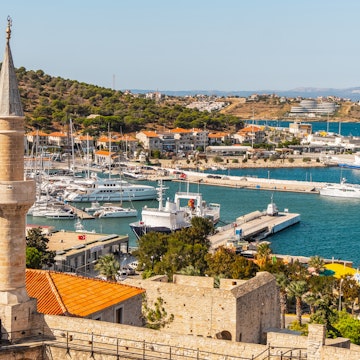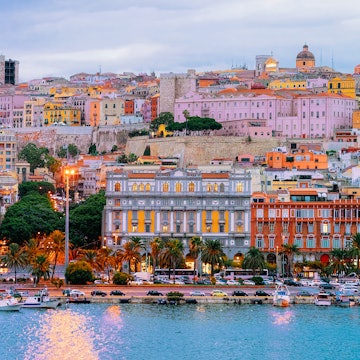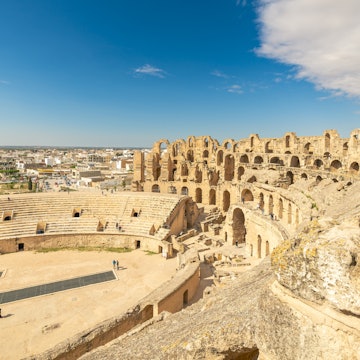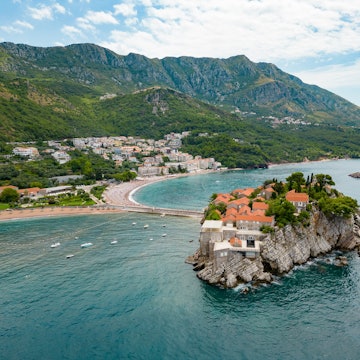

Antonine Baths in the ancient city of Carthage, Tunisia. Jess Kraft/Shutterstock
Tunisia is increasingly making its way onto the wish lists of many travelers, thanks to its well-preserved Roman cities, atmospheric medinas, picturesque seaside villages and diversity of natural beauty. And with the country’s relatively small size in relation to its North African neighbors, you could be voyaging into the dune-ruffled sweeps of the Sahara Desert in the south, observing the birdlife-rich marshlands of Lake Ichkeul in the north and investigating the remarkable ruins of ancient empires all in the space of a few days.
Start planning your trip today with these 14 quintessential Tunisia experiences.

1. Wander through ancient cities
Tunisia has known many phases, many personalities, defined in part by the passage of time and the rise and fall of empires. The Romans left the most indelible imprint and many of their cities, although in ruins, remain remarkably intact. At Dougga, your imagination is barely needed at all, so well preserved are the bathhouses, temples and theater. Exquisite mosaics remain in situ, protected from the elements for centuries in the remarkable subterranean Roman-Berber villas of Bulla Regia. Meanwhile on home turf, the Carthaginians operated their empire out of Carthage, whose memories decorate the eastern suburbs of modern-day Tunis. And the UNESCO-listed city of Kairouan, the ancient base of the Maghreb, has excellent traditional medinas and historical sites, including the Grand Mosque.
Planning tip: Drop by the Bardo Museum in Tunis to discover the Roman mosaics and statues from various ancient civilizations that help make this Tunisia’s finest archaeological collection.
2. Spot flamingos, storks and gallinules around Lake Ichkeul
Ichkeul National Park is Tunisia’s sole natural UNESCO World Heritage Site (the rest are cultural). A freshwater lake for half of the year and brackish for the other half, Lake Ichkeul’s ecosystem is unique in North Africa and extremely fragile. These conditions lure an impressive number of birds (around 230 different species), making it a birdwatching haven. Flamingos are popular, but the storks and purple gallinules add plenty of color and character of their own.
Planning tip: Permits must be acquired in advance of your trip to Ichkeul. Apply via a local tour agency at least a few weeks prior.

3. Burrow into a medina
As long as you don’t have a fear of crowded spaces, the medinas of most towns and cities around Tunisia are fascinating and beguiling spaces to explore. So much so that the medinas of Sousse and Tunis are both inscribed on UNESCO’s World Heritage List, while the medina of Sfax is a perfect place to pick up a unique souvenir and enjoy a spot of people-watching in the busy port city. These vital neighborhoods teem with historic buildings, commerce at the souks (markets) and intrigue, fueled by their discombobulating tangle of narrow alleys.
Detour: Take your exploration of the medinas one step further and consider booking your accommodation at a Tunisian dar. These traditional family homes are often buried deep in the medinas, offering guest rooms – which are arranged around a central courtyard – to travelers.
4. Buy terra-cotta pottery directly from Amazigh artists
In the midst of Northern Tunisia’s rolling green hills, Sejnane is an unassuming little town with no hotels and very little tourism. And yet, this region is home to the UNESCO Intangible Cultural Heritage-listed artform of Sejnane pottery. Roadsides throughout the surrounding towns and villages are lined with stalls selling an assortment of terra-cotta bowls, figurines and other utensils handmade and handpainted by local women. The designs, often in black, red, white and ochre, are inspired by local nature and relate to the Amazigh (aka Berber) tradition.

Meet your new travel partner
Get unlimited data while you travel with Holafly eSIM. Peace of mind and no hidden fees wherever you go. Use code LONELYPLANET for an exclusive discount.

5. Trek through the Sahara Desert
Camels are remarkable creatures, uniquely evolved to survive the water scarcity, heat and dust of the deserts. Humans, not so much. As such, camels have long been a lifeline amid and over the dunes. Notwithstanding the silver-screen romanticization of trekking with camels through the desert, it’s important to only use companies that treat the animals well. Douz, known as the gateway to the Sahara, is the best place to take a tour. Options range from an hour-long plod and overnight treks to 10-day expeditions, giving you a chance to leave all the trappings of modern civilization behind.
Detour: A great alternative to the four-legged treks is to take a 4WD tour.
6. Discover one of the world’s oldest mosques
The Great Mosque of Kairouan (aka Sidi Okba Mosque) is the oldest in the Maghreb (Northwest Africa). Although the current building largely dates to the late 9th century CE, it was built over the original, dating back to 670CE, elements of which still survive. The buttressed exterior walls are devoid of ornament, typical of the time when built, but the courtyard’s fountains and the 414 interior pillars with horseshoe arches are elegantly carved.
Planning tip: Non-Muslims can only visit the courtyard and only via the main, dome-topped portico gate on Rue Okba Ibn Nafaa, if dressed appropriately (robes are available at the entrance). Doors from the courtyard to the mosque’s interior are usually kept open for visitors to see inside.

7. Get some sun in Cap Bon
During the high heat of summer, which often surpasses 100°F (37.8°C) in the cities, it seems as though half of Tunisia heads down to the beach. With more than 1148km (713 miles) of Mediterranean coastline, Tunisia offers some spectacular beaches, which vary wildly in terms of cleanliness. Those along Cap Bon are the best, including the activity-rich beaches of Hammamet, with its colorful fishing boats, the white sand and azure seas of Plage de la Mansoura and the hard-to-reach secluded coves of Port Aux Prince.
8. Learn how to protect your grain
The Amazigh (Berber) of Southern Tunisia were adept at adapting to the harsh realities of life on the fringes of the Sahara Desert. That survival instinct included developing fortified granaries to protect the vital resources of food and water from pilfering bands of brigands. The result is a series of otherworldly multistory grain vaults called ghorfas. Most impressive are those at Ksar Oued Soltane, although the ghorfas at Ksar Ezzahra are worth the detour.

9. Explore hilltop Amazigh villages
On the Sahara’s edge, around 24km (15 miles) outside of Tataouine in the southeast of the country, are a chain of traditional Amazigh (Berber) hilltop villages. The most photogenic is Chenini, where most dwellings are built around natural caves beneath a ridgetop fortification. Only the mosque, painted a brilliant white, stands out from the sandstone. Make sure you ask for the old towns when taking a taxi, as the new towns, built lower down the slopes but given the same name, have little to recommend them. A less-touristed alternative is Douiret.
Planning tip: You’ll need a 4WD to reach these Old Town sites, and this, together with the Star Wars sites and Sahara trips, is part of a well-worn tourist "safari" circuit, so it’s always possible to arrange through local hotels if you don’t book in advance.
10. Dive down to rare red corals
Although Tabarka has been one of Tunisia’s slowest tourist towns to recover post-Covid, it remains one of the country’s best places for scuba diving trips. That’s thanks largely to the carmine corals that grow at dive sites such as Roches de Mérous (Grouper Rocks) and La Grotte aux Pigeons (Pigeon Cave). Club Nautique de Tabarka runs dives to these spots and more throughout the year.
Detour: During the summer months, it’s usually also possible to arrange diving trips to the Galite Islands, 62km (39 miles) north of Tabarka.

11. Saber your way through Tunisia’s Star Wars filming locations
Part of western Tunisia’s Sahara region is globally renowned after its role in the Star Wars franchise as the imaginatively named desert planet Tatooine (same pronunciation as the Tunisian town). Foremost among the recognizable filming locations is Chott el Djerid salt flats, used for the Lars Homestead’s exterior scenes. Mos Espa, used as Tatooine’s spaceport, remains one of the best-preserved Star Wars filming locations in Tunisia.
Detour: Stay in Star Wars territory with a night at Hotel Sidi Idriss, over in Matmata, whose underground rooms were used for filming Lars Homestead’s indoor scenes.
12. Take a Jebil National Park safari
If you thought the desert was a barren, empty space, think again. Jebil is, at 1,500 square kilometers, Tunisia’s largest national park, protecting the delicate dune ecosystems that harbor a surprising array of life. Safaris, often by 4WD from Douz, seek out the region’s resident species, including dorcas gazelle, fennec fox and Barbary sheep, plus species of bird such as Houbara bustard and desert sparrow.

13. Try the brik in Bizerte
Seafood is a staple of the Tunisian diet, making its way into many of the country’s main dishes, including seafood couscous and brik, a triangular deep-fried pastry filled with potatoes, eggs and tuna. Brik is available throughout the country, but particularly in seaside cities such as Bizerte and Sfax, which are both known for their excellent seafood. The latter is also famed for its signature dish loup à la Sfaxienne: sea bass baked with capers, tomatoes, onions, garlic and peppers.

14. Visit El Jem’s Roman Amphitheater
One of the Roman world’s most beguiling legacies, mimicked at every sports arena and stadium still today, is the amphitheater. El Jem’s is the world’s third-largest Roman colosseum, and is really only second to that of Rome in terms of preservation quality. Constructed between 230 and 238CE, it is listed as a UNESCO World Heritage Site, with three tiers still intact. The amphitheater once seated 35,000 people.
Detour: Stick around in El Jem, referred to as Thysdrus in Roman times, for its Archaeological Museum, which contains the remnants of a Roman villa called The House of Africa.














